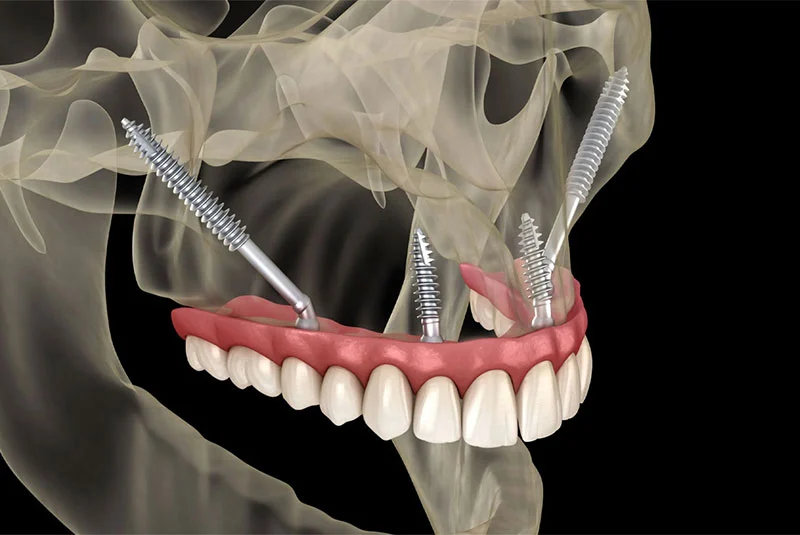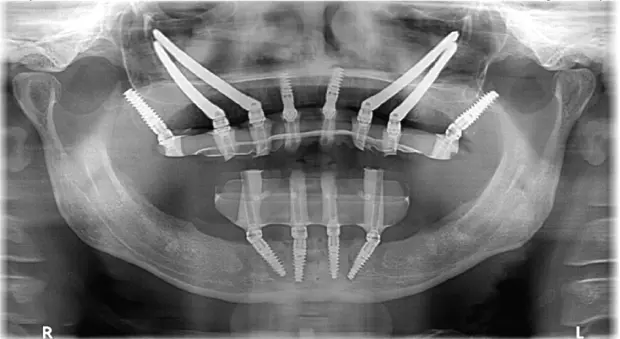Zygomatic Implants

What Are Zygomatic Dental Implants?
Zygomatic implants are special dental implants used when there is insufficient bone in the upper jaw to support standard dental implants. Instead of being placed in the lower jaw, these implants are placed in the cheekbone (zygomatic bone) to support teeth or bridges. This allows patients with bone deficiency in the upper jaw to still receive stable support for their teeth or dentures. Zygomatic implants are often an effective option for those who have experienced bone loss in the upper jaw due to prolonged tooth loss or other medical conditions.

Advantages of Zygomatic Dental Implants
- Bone Deficiency Solution: Zygomatic implants allow patients with significant bone loss in the upper jaw to receive dental implants without the need for additional bone grafting procedures.
- Stability and Support: Using the cheekbone for implant support provides stability and long-term support for teeth or dentures, improving smile functionality and aesthetics.
- Less Invasive Procedure: Unlike other bone grafting methods that require additional surgical procedures or bone transplantation, zygomatic implant placement can reduce the invasiveness of the procedure and recovery time.
- Faster Rehabilitation: Due to reduced invasiveness and fewer surgical interventions, rehabilitation after zygomatic implant placement may be quicker compared to other bone grafting methods.
- Efficiency: Zygomatic implants offer a reliable and efficient option for patients with severe bone loss in the upper jaw, allowing them to regain smile functionality and aesthetics.
Who Are Candidates for Zygomatic Dental Implants?
Candidates for zygomatic dental implants typically include patients who meet the following criteria:
1. Severe Bone Deficiency: Individuals with significant bone loss in the upper jaw, which may result from prolonged tooth loss, gum disease, or other medical conditions, may be suitable candidates for zygomatic implants.
2. Inability for Standard Implants: Patients who lack sufficient bone for standard dental implants and are not suitable for bone grafting procedures may be ideal candidates for zygomatic implants.
3. Patients with Upper Jaw Tooth Loss: Individuals who have lost a significant number of teeth in the upper jaw and experience instability with dentures or other tooth replacement methods may benefit from zygomatic implants to stabilize prosthetic solutions.
4. General Health: Candidates for zygomatic implants should also be in relatively good overall health, without serious medical conditions that may compromise the success of the procedure and recovery.
5. Psychosocial Factors: In addition to medical criteria, it is important for candidates to have realistic expectations of the procedure and be motivated to maintain good oral hygiene and regular dental check-ups after implant placement.

Zygomatic Dental Implant Installation Procedure
The procedure for installing zygomatic dental implants is a complex process that requires careful planning and execution by a qualified oral surgeon or dentist experienced in this field. Here are the basic steps in the zygomatic dental implant installation procedure:
1. Examination and Planning: The first step in the procedure is a detailed examination of the patient’s oral health, including X-rays and possible scanning of the upper jaw to assess the amount of bone and the position of the zygomatic bones. Based on this information, the dentist will create a plan for installing zygomatic implants.
2. Preparation for Surgery: Before the surgery, the patient will be informed about all the steps of the procedure and may be given instructions on how to prepare, including discontinuing certain medications or dietary restrictions.
3. Implant Installation: During the surgery, the dentist will make an incision in the gums to expose the cheekbone. Special surgical tools and techniques will then be used to place the implants into the cheekbone at appropriate sites. Typically, two zygomatic implants are used on each side of the upper jaw.
4. Fixing Temporary Prosthetics: After the implants are placed, the dentist may fix temporary dentures or bridges to provide the patient with functional teeth during the healing period.
5. Healing and Integration: After the surgery, the patient will undergo a healing period during which the implants will gradually fuse and integrate with the surrounding bone. This process may take several months, during which the patient will regularly visit for check-ups to monitor healing and recovery.
6. Attaching Permanent Prosthetic Solutions: Once the implants are fully integrated, the patient will receive permanent prosthetic replacements, such as bridges or dentures, which will be anchored to the zygomatic implants. These permanent replacements will provide stable support and functionality to the mouth, allowing the patient to chew and speak normally.
7. Postoperative Care: After the placement of permanent prosthetic solutions, the patient will receive instructions on postoperative care and regular check-ups to ensure the long-term health and functionality of the implants and replacements.
It is important to note that each patient may have individual specificities and needs regarding the zygomatic dental implant installation procedure, so it is crucial for the dentist to customize the procedure to fit those needs.
